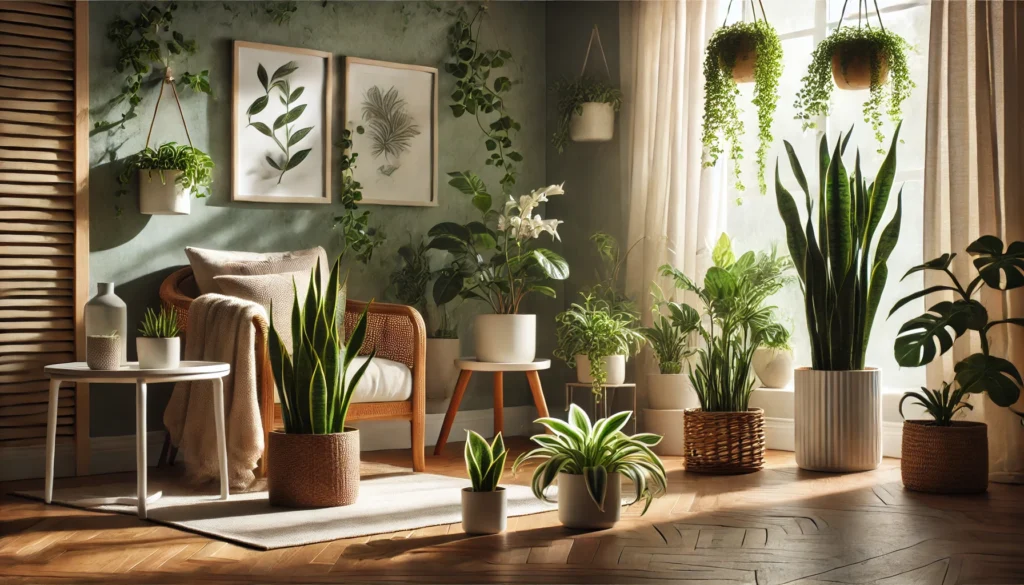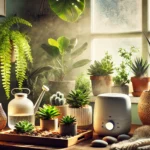Indoor plants are more than just decorative additions to your home; they can also improve indoor air quality by filtering toxins and releasing oxygen. Certain plants are particularly effective at purifying the air, making them excellent choices for creating a healthier indoor environment. In this guide, we’ll discuss some of the best air-purifying plants, how to identify them, and tips for their care.
Benefits of Air-Purifying Plants
Air-purifying plants offer several benefits that contribute to a healthier indoor atmosphere:
- Improved Oxygen Levels: Plants release oxygen, enhancing air quality and supporting better breathing.
- Toxin Reduction: Many houseplants filter out common indoor pollutants, such as formaldehyde, benzene, and carbon monoxide.
- Increased Humidity: Plants release moisture, which can be beneficial in dry indoor environments, helping to prevent respiratory issues.
Top Air-Purifying Houseplants to Consider
Here are some popular air-purifying plants that not only enhance your home’s look but also contribute to cleaner indoor air.
1. Snake Plant (Sansevieria trifasciata)
Snake plants, also known as mother-in-law’s tongue, are one of the best air-purifying plants. They are hardy, easy to care for, and filter out toxins like formaldehyde and benzene.
- Light: Low to bright, indirect light.
- Water: Allow soil to dry between waterings.
- Care Tip: Snake plants thrive on neglect, making them perfect for beginners.
2. Spider Plant (Chlorophytum comosum)
Spider plants are known for their air-purifying qualities and are particularly effective at removing carbon monoxide and formaldehyde. They are pet-friendly and easy to propagate.
- Light: Bright, indirect light.
- Water: Keep soil slightly moist.
- Care Tip: Trim off any brown tips to keep the plant looking fresh.
3. Peace Lily (Spathiphyllum)
Peace lilies are elegant plants that help remove toxins like ammonia and benzene. They are known for their striking white blooms and air-cleaning abilities.
- Light: Low to medium indirect light.
- Water: Keep soil consistently moist, but avoid overwatering.
- Care Tip: Peace lilies benefit from regular misting to maintain humidity.
4. Boston Fern (Nephrolepis exaltata)
Boston ferns are excellent for increasing indoor humidity and filtering out pollutants. Their lush, feathery fronds add a touch of nature to any room.
- Light: Indirect light with high humidity.
- Water: Keep soil consistently moist.
- Care Tip: Mist regularly or use a humidity tray to maintain moisture levels.
5. Aloe Vera (Aloe barbadensis)
Aloe vera not only purifies the air but also has medicinal properties, such as soothing burns. It is a low-maintenance succulent that’s easy to grow indoors.
- Light: Bright, indirect to direct light.
- Water: Allow soil to dry completely before watering.
- Care Tip: Place aloe vera in a sunny spot and avoid overwatering.
6. English Ivy (Hedera helix)
English ivy is a classic air-purifying plant that removes toxins like formaldehyde and benzene. It can be grown in pots or allowed to trail for a decorative effect.
- Light: Bright, indirect light.
- Water: Keep soil evenly moist.
- Care Tip: Trim regularly to control growth and prevent legginess.
7. Bamboo Palm (Chamaedorea seifrizii)
Bamboo palms are effective at removing indoor pollutants and adding a tropical feel to your home. They are safe for pets and relatively easy to care for.
- Light: Bright, indirect light.
- Water: Keep soil slightly moist, but avoid overwatering.
- Care Tip: Dust the leaves regularly to keep them clean and healthy.
8. Golden Pothos (Epipremnum aureum)
Golden pothos is a fast-growing, hardy plant that cleans the air by removing formaldehyde and benzene. Its trailing vines add greenery to any indoor space.
- Light: Low to bright, indirect light.
- Water: Allow the top inch of soil to dry out between waterings.
- Care Tip: Prune regularly to encourage bushier growth and maintain shape.
9. Rubber Plant (Ficus elastica)
Rubber plants are attractive and efficient at filtering toxins like formaldehyde. They have thick, glossy leaves that add a touch of elegance to any room.
- Light: Bright, indirect light.
- Water: Keep soil consistently moist during the growing season, reduce watering in winter.
- Care Tip: Wipe leaves with a damp cloth to remove dust and improve air-purifying efficiency.
10. ZZ Plant (Zamioculcas zamiifolia)
ZZ plants are virtually indestructible and help remove toxins from the air. They have glossy, dark green leaves and thrive in low-light conditions.
- Light: Low to bright, indirect light.
- Water: Allow soil to dry completely between waterings.
- Care Tip: ZZ plants are drought-tolerant, so avoid overwatering.
Tips for Caring for Air-Purifying Plants
Proper care ensures that air-purifying plants remain healthy and effective in improving indoor air quality. Here are some essential care tips:
1. Maintain Proper Watering
Each plant has unique watering needs, so it’s essential to understand the requirements of each.
- Check Soil: Always check soil moisture before watering to avoid overwatering.
- Watering Routine: Develop a watering schedule based on each plant’s needs and your home’s humidity level.
2. Provide Adequate Light
Light is crucial for plant health, but too much or too little can affect growth.
- Positioning: Place plants in locations that match their light requirements. For example, aloe vera prefers bright light, while peace lilies do well in low light.
- Rotate Plants: Rotate plants every few weeks to ensure even light exposure.
3. Clean Leaves Regularly
Dust can accumulate on plant leaves, blocking light and reducing their air-purifying effectiveness.
- Wipe with a Damp Cloth: Gently wipe leaves with a damp cloth to remove dust.
- Spray with Water: For delicate plants, misting with water can help maintain cleanliness.
4. Avoid Chemical Fertilisers
Chemical fertilisers can reduce the air-purifying benefits of indoor plants and may be harmful if ingested by pets.
- Use Organic Fertiliser: Organic fertilisers provide nutrients without introducing harmful chemicals.
- Fertiliser Frequency: Apply fertiliser sparingly, typically every few months during the growing season.
Creating an Indoor Garden for Maximum Air Purification
To maximise the air-purifying effects of your plants, consider grouping them in different rooms of your home.
- Bedrooms: Place snake plants or aloe vera in bedrooms to help improve air quality while you sleep.
- Living Areas: Use large plants like bamboo palms or rubber plants in common areas for enhanced purification.
- Bathrooms: High-humidity areas are ideal for Boston ferns or spider plants, which thrive in moist conditions.
Conclusion: Enjoy a Healthier Home with Air-Purifying Plants
Incorporating air-purifying plants into your home not only enhances your décor but also contributes to a cleaner, healthier indoor environment. With the right selection and care, these plants will filter toxins, increase humidity, and support overall well-being. By following these tips, you can create an indoor garden that brings beauty and health benefits to your living space.

Meet Claudia Boaski, an enthusiast in pet care, plants, and home wellness. She is dedicated to helping people create harmonious and welcoming homes, fostering a deep connection with nature and their furry companions.







